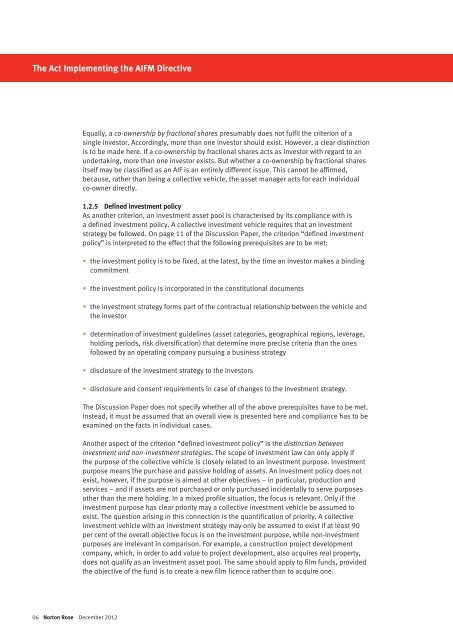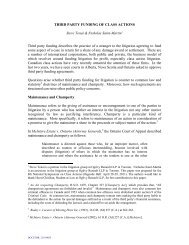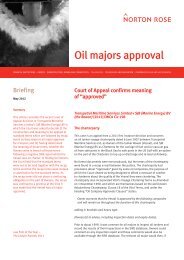The Act Implementing the AIFM Directive - Norton Rose
The Act Implementing the AIFM Directive - Norton Rose
The Act Implementing the AIFM Directive - Norton Rose
You also want an ePaper? Increase the reach of your titles
YUMPU automatically turns print PDFs into web optimized ePapers that Google loves.
<strong>The</strong> <strong>Act</strong> <strong>Implementing</strong> <strong>the</strong> <strong>AIFM</strong> <strong>Directive</strong><br />
06 <strong>Norton</strong> <strong>Rose</strong> December 2012<br />
Equally, a co-ownership by fractional shares presumably does not fulfil <strong>the</strong> criterion of a<br />
single investor. Accordingly, more than one investor should exist. However, a clear distinction<br />
is to be made here. If a co-ownership by fractional shares acts as investor with regard to an<br />
undertaking, more than one investor exists. But whe<strong>the</strong>r a co-ownership by fractional shares<br />
itself may be classified as an AIF is an entirely different issue. This cannot be affirmed,<br />
because, ra<strong>the</strong>r than being a collective vehicle, <strong>the</strong> asset manager acts for each individual<br />
co-owner directly.<br />
1.2.5 Defined investment policy<br />
As ano<strong>the</strong>r criterion, an investment asset pool is characterised by its compliance with is<br />
a defined investment policy. A collective investment vehicle requires that an investment<br />
strategy be followed. On page 11 of <strong>the</strong> Discussion Paper, <strong>the</strong> criterion “defined investment<br />
policy” is interpreted to <strong>the</strong> effect that <strong>the</strong> following prerequisites are to be met:<br />
• <strong>the</strong> investment policy is to be fixed, at <strong>the</strong> latest, by <strong>the</strong> time an investor makes a binding<br />
commitment<br />
• <strong>the</strong> investment policy is incorporated in <strong>the</strong> constitutional documents<br />
• <strong>the</strong> investment strategy forms part of <strong>the</strong> contractual relationship between <strong>the</strong> vehicle and<br />
<strong>the</strong> investor<br />
• determination of investment guidelines (asset categories, geographical regions, leverage,<br />
holding periods, risk diversification) that determine more precise criteria than <strong>the</strong> ones<br />
followed by an operating company pursuing a business strategy<br />
• disclosure of <strong>the</strong> investment strategy to <strong>the</strong> investors<br />
• disclosure and consent requirements in case of changes to <strong>the</strong> investment strategy.<br />
<strong>The</strong> Discussion Paper does not specify whe<strong>the</strong>r all of <strong>the</strong> above prerequisites have to be met.<br />
Instead, it must be assumed that an overall view is presented here and compliance has to be<br />
examined on <strong>the</strong> facts in individual cases.<br />
Ano<strong>the</strong>r aspect of <strong>the</strong> criterion “defined investment policy” is <strong>the</strong> distinction between<br />
investment and non-investment strategies. <strong>The</strong> scope of investment law can only apply if<br />
<strong>the</strong> purpose of <strong>the</strong> collective vehicle is closely related to an investment purpose. Investment<br />
purpose means <strong>the</strong> purchase and passive holding of assets. An investment policy does not<br />
exist, however, if <strong>the</strong> purpose is aimed at o<strong>the</strong>r objectives – in particular, production and<br />
services – and if assets are not purchased or only purchased incidentally to serve purposes<br />
o<strong>the</strong>r than <strong>the</strong> mere holding. In a mixed profile situation, <strong>the</strong> focus is relevant. Only if <strong>the</strong><br />
investment purpose has clear priority may a collective investment vehicle be assumed to<br />
exist. <strong>The</strong> question arising in this connection is <strong>the</strong> quantification of priority. A collective<br />
investment vehicle with an investment strategy may only be assumed to exist if at least 90<br />
per cent of <strong>the</strong> overall objective focus is on <strong>the</strong> investment purpose, while non-investment<br />
purposes are irrelevant in comparison. For example, a construction project development<br />
company, which, in order to add value to project development, also acquires real property,<br />
does not qualify as an investment asset pool. <strong>The</strong> same should apply to film funds, provided<br />
<strong>the</strong> objective of <strong>the</strong> fund is to create a new film licence ra<strong>the</strong>r than to acquire one.













